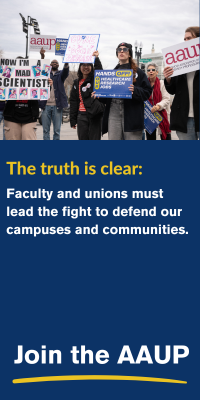- About
- Programs
- Issues
- Academic Freedom
- Political Attacks on Higher Education
- Resources on Collective Bargaining
- Shared Governance
- Campus Protests
- Faculty Compensation
- Racial Justice
- Diversity in Higher Ed
- Financial Crisis
- Privatization and OPMs
- Contingent Faculty Positions
- Tenure
- Workplace Issues
- Gender and Sexuality in Higher Ed
- Targeted Harassment
- Intellectual Property & Copyright
- Civility
- The Family and Medical Leave Act
- Pregnancy in the Academy
- Publications
- Data
- News
- Membership
- Chapters
From the Editor: Activism 2017
We have work to do.
American higher education, like all American cultural institutions, faces severe threats. Many of these are already manifest, as at Long Island University, where faculty were locked out of their classrooms for a time last fall in a direct challenge to principles of shared governance. Some are less obvious but longer term, such as the attempt to transform colleges into trade schools serving the needs of corporations no longer willing to train their own workers. Others attack the bedrock of what “college” has become over the past half century, including belief in the importance of diversity on campus. At the onset of Donald Trump’s presidency, there is good reason to believe that such threats will only increase in number and severity.
Each of these threats challenges the assumptions that have sustained the AAUP for a century. Each must be countered, and with vigor. For the faculty to survive with cohesiveness and influence intact, we must first strengthen our organizations and commitments. We cannot allow decisions about our institutions to be made without our participation.
Our slow slide into complacency needs to come to an end. We all must become activists, recognizing the strength of one in developing the power of many. Each of us needs to recruit new members to the AAUP, to become a participant in our unions and advocacy organizations, to stand up for diversity and disability rights, to insist on having a voice in campus decisions, and to protect academic freedom and tenure. Those of us who are tenured or on the tenure track need to make common cause with faculty on contingent appointments, who are increasingly doing yeoman’s work in our colleges and universities. Contingent faculty, exploited though they are, need to recognize the urgency of unity, though without ceding the fight for their own issues.
The victory of the forces of regression will become permanent only if we allow it. The election results of last fall are not a mandate for change but a protest against the future. The future is hard and the past often seems comfortable, especially when one’s idea of what is to come suffers, as it has for many Americans, from the realities of widening disparity and narrowing vision. We need to demonstrate that our goals include everyone, not simply an elite few or people from particular circumstances. We have to work better and smarter, we have to do it together, and we have to do it now.
Leading off this issue is Jamie Owen Daniel’s look at the recent Friedrichs case, which will surely be followed by other attacks on organized labor. Following that, Marcella Bencivenni argues that faculty, staff, and student unity may be the best way to save higher education. Sonya D. Hester, Harolyn Wilson, and Joslin Pickens detail the revitalization of faculty structures on their campus, David P. Nalbone suggests we make numbers work for us in negotiations, and Martha T. McCluskey takes a critical look at campus foundations. William Beaver concludes the print edition with an account of the decline of the for-profits— institutions that may rebound under the Trump administration. In our online edition, Timothy V. Kaufman-Osborn provides historical background to the Wisconsin debacle and Michael DeCesare emphasizes the importance of AAUP principles of academic governance.
Read the articles in this issue, but don’t weep. Organize.



